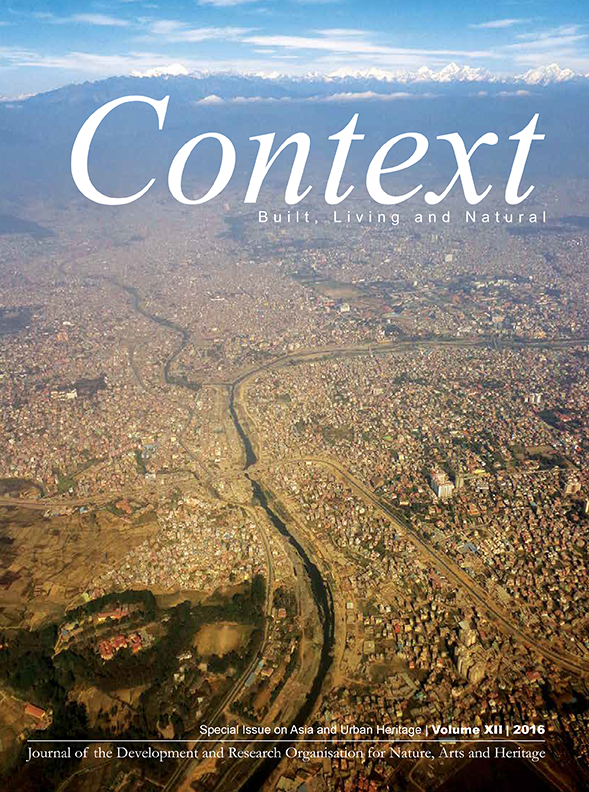About the Volume
Increasing urbanisation in Asian cities as recorded in global UN documents in last decade is hugely impacting the vast repository of historic cities in the region. In such a scenario, conservation practices for Asia’s urban heritage provide a valuable insight into the future of historic cities in the region. This special issue on Asia’s urban heritage presents a wide perspective of approaches to urban conservation in a range of Asian countries. Clearly, the living urban heritage that sustains the historic cities of Asia requires its own regional and sub regional approach to conservation that sets it apart from models in Europe or other parts of the world.
Introductory articles by Minja Yang and Amreshwar Galla provide an overview of Asia’s Urban Heritage and the notion of ‘Culture and Development’ as outlined in UNESCO conventions and UN Habitat documents on Culture, at the same time emphasising the need for customised approach in applying such UN guidelines on ground as in examples of Hoi An and Amravati. Kai Weise and Imon’s case studies from Nepal and Bangladesh emphasise that sustainability of historic cities in Asia resides in aspects of cultural identity and continuity of the intangibles; that even allows the city to regain its status quo post disaster or directly contributes to its socio-economic development. Water based cultural landscapes in Thailand and Japan emphasise the integral link of natural setting in mobility systems and infrastructure development of such Asian cities while, the case of Pyu ancient cities from Myanmar brings forth the need of aligning urban management systems as per World Heritage guidelines.
Official recognition of urban heritage in India is a fairly recent phenomenon even though few pioneering cases of urban conservation became evident in cities like Mumbai, Delhi, Puducherry, Jaipur and Ahmedabad in the last decade. While the Ministry of Urban Development (MoUD), India began to acknowledge the need of documents such as a city level heritage plan in 2013, it is the recently launched flagship programmes such as HRIDAY (Heritage City Development and Augmentation Yojna) in 2015 that are truly encouraging for the future of historic Indian cities. Beyond HRIDAY that directly caters to urban heritage of 12 cities, the Ministry schemes provide convergence opportunities with other programmes such as AMRUT and SMART city that can also be used for urban renewal of historic city cores in India. The central section of this journal elaborates on these national schemes and their implementation in a few cities.
Safeguarding of urban heritage as part of larger international and national agendas is critical; however, it is local approaches at ground level that finally determine the success of urban regeneration of historic areas. The last section of this special issue is hence, devoted to small scale approaches that form the basis for documentation, protection and conservation of urban heritage in Indian cities.
Shikha Jain
Contents
About the Volume
Asia Perspective on Urban Heritage
Humanising the City: Trends in Asia Pacific
Minja Yang
Culture and Development in New Urban Agenda: Learning from Hoi An
and Amravati
Amareswar Galla
Public Participation and Sustainable Urban Conservation
Sharif Shams Imon
Damage and Continuity: Kathmandu Valley
Kai Weise
Water based Cultural Landscapes: Ban Kong and Ban Pakklong, Thailand
Witiya Pittungnapoo
Revitalisation and Community Engagement: Otsu, Japan
Dowon Kim
Management Systems for World Heritage: Pyu Ancient Cities, Myanmar
Su Su and Win Kyaing
The India Perspective: National Scenario for Urban Heritage
Heritage Cities of India: Facts, figures and issues
Snigdha Bisht and Moe Chiba
Heritage City Development and Augmentation Yojana: An overview
Ryan Christopher Sequeira
Leveraging National Schemes to Support a Heritage Agenda
Mukta Naik and Kimberly M Noronha
Cities in Focus
Streamlining Urban Initiatives: Ajmer
Uditi Agarwal
Rejuvenating the Soul of Historic Cities: Amritsar and Puri
Gurmeet S Rai and Priyanka Singh
Waiting for a Turnaround: Dwarka
Manvita Baradi and Anurag Anthony
From Political to Cultural Capital: Redefining the role of old
Bhubaneswar
Sanghamitra Basu
Local Approaches
Making Heritage Relevant to the Local Community: Chandernagore
and Chinsurah
Aishwarya Tipnis
Modern Urban Heritage and Public Engagement: The case of
Thiruvananthapuram
Thomas Oommen
Common Property Resource: Traditional water system of Delhi
Suruchi Shah
Traditional Knowledge and Systems: Pilgrimage town of Jejuri
Vaishali Davalbhakta-Latkar and Abhijit Natu
Documenting Urban Heritage
Visual Documentation as a Tool for Conservation, Part II:
Dalhousie Square and surroundings, Kolkata
Himadri Guha, Biswajit Thakur and Kaninika Dey Sarkar
Muthas of Tuljapur: Sustainable traditional infrastructure
Tejashree Lakras and Pallavi Dalal
Documenting Kishangarh
Yash Pratap Singh Shekhawat
Book Review
Assorted City: Equity, justice, and politics in urban services delivery
by Suptendu P Biswas
Reviewed by Ajay Khare

